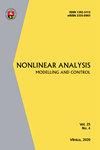应用人工神经网络解决从生物传感器信号中评估多分析物混合物浓度的反问题
IF 2
3区 数学
Q1 MATHEMATICS, APPLIED
引用次数: 0
摘要
我们研究了当生物传感器信号被噪声破坏时逆生物传感器问题的病态性。为了解决这个问题,我们采用了前馈和卷积神经网络。对生物传感器的间歇注射和流动注射分析模式进行了不同程度的加性和乘性噪声的计算实验。得到的结果表明,在训练域的边缘处恢复的浓度误差最大。我们发现,在流动注射分析模式下,逆问题的病态性较小,并且与批处理模式相比,在较高的噪声水平下可以可靠地恢复浓度。将DIRECT全局优化方法应用于所考虑的逆生物传感器问题,证实了这一发现。本文章由计算机程序翻译,如有差异,请以英文原文为准。
Applying artificial neural networks to solve the inverse problem of evaluating concentrations in multianalyte mixtures from biosensor signals
We investigate the ill-posedness of the inverse biosensor problem when the biosensor signals are corrupted by noise. To solve the problem, we employ feed-forward and convolutional neural networks. Computational experiments were performed with different levels of additive and multiplicative noises for the batch and flow injection analysis modes of the biosensor. Obtained results show that the largest errors of recovered concentrations are located on the edges of the training domain. We have found that the inverse problem is less ill-posed in the flow injection analysis mode and concentrations can be reliably recovered for higher levels of noise compared to the batch mode. This finding is confirmed by the application of the DIRECT global optimization method to the considered inverse biosensor problem.
求助全文
通过发布文献求助,成功后即可免费获取论文全文。
去求助
来源期刊

Nonlinear Analysis-Modelling and Control
MATHEMATICS, APPLIED-MATHEMATICS, INTERDISCIPLINARY APPLICATIONS
CiteScore
3.80
自引率
10.00%
发文量
63
审稿时长
9.6 months
期刊介绍:
The scope of the journal is to provide a multidisciplinary forum for scientists, researchers and engineers involved in research and design of nonlinear processes and phenomena, including the nonlinear modelling of phenomena of the nature. The journal accepts contributions on nonlinear phenomena and processes in any field of science and technology.
The aims of the journal are: to provide a presentation of theoretical results and applications; to cover research results of multidisciplinary interest; to provide fast publishing of quality papers by extensive work of editors and referees; to provide an early access to the information by presenting the complete papers on Internet.
 求助内容:
求助内容: 应助结果提醒方式:
应助结果提醒方式:


